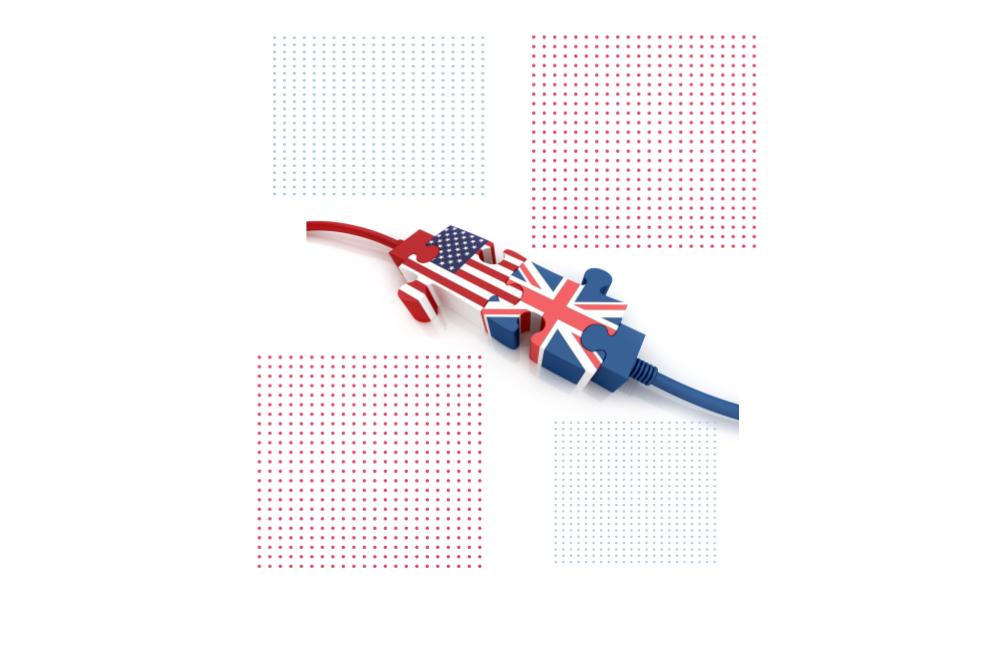
Author Matt Sammon
Trade Mark rights are territorial and it’s important to secure protection for your IP portfolio in each market that your business trades in. Following Brexit and the history of the UK’s ‘special’ relationship with the US many British brands are looking across the pond to expand their commercial horizons and reach new consumers. If your brand has or intends to create a market share in the US it’s worthwhile ensuring that you understand both UK and US Trade Mark Law to minimise the risk of any costly mistakes relating to your IP.
In this article, we’ll highlight the key considerations for protecting your trade marks in the US and the key differences to UK protection you need to be aware of.
The trade relationship between the UK and US
British Prime Ministers have claimed to have enjoyed a ‘special’ relationship with the US ever since Winston Churchill coined the phrase in the aftermath of World War Two and the economics certainly support these claims. The UK exports more goods to the US than any other country. Almost 15% of the UK’s goods exports went to the US last year and the US is also the country that sees the most UK services exports.
The ability to negotiate trade deals with countries like the US was a key part of the leave case for Brexit and whilst a trade deal is likely to be some years away it is clear that the US is an important market for UK businesses and Brexit is only likely to strengthen that position. The increased difficulties in trading in the European Union will no doubt cause businesses to go west and look to the US market.
Trade Mark Protection in the UK
The trade mark registration system in the UK is amongst the most efficient and cost effective in the world. It currently takes around 5 months to secure registration with rights backdated to the day of filing an application. Registrations are protected for an initial 10 years and may be renewed every 10 years upon payment of a renewal fee.
Trade Mark applications are examined to ensure that they meet the minimum requirements for distinctive character, the properties that enable your brand to distinguish your goods or services from your competitors. The UK Intellectual Property Office (UKIPO) will also conduct a search of prior rights, however, they will not reject an application on the basis of an earlier right unless the owner of such a right formally files and succeeds with opposition.
Trade Mark Protection in the US
The trade mark registration process in the US has some very significant differences and the process is administered by the United States Patent and Trademark Office (USPTO).
If you are looking to secure trade mark protection in the US to pays to look ahead and start as soon as possible. It is not uncommon for applications to take 18-24 months. The examination process is much more in depth and typically the first examination report will not issue until 6 months after an application has been filed.
The USPTO will examine the distinctive character of a trade mark and conduct a prior rights search, like the UKIPO, however, one key difference is that the USPTO will reject an application if they feel that it is confusingly similar to an existing registration. Consequently, before incurring the cost of filing a trade mark application in the US it is particularly important to conduct a search of the register to see if any objections are likely.
The USPTO will also require a very defined list of goods and services and will not as readily grant protection to broad categories as the UKIPO.
What is your basis for filing a trade mark in the US?
Another key differencebetween UK and US Trade Mark Law and filing a trade mark in the US is that you need a ‘basis’ for filing an application. The ‘basis’ that you can claim must be one of the following:
- Use in commerce – you are currently using the trade mark in interstate trade in the US for the goods and/or services for which you are seeking registration
- Intent to use – you have a bona fide intent to use the trade mark for the goods and services in interstate trade in the US in the near future. Note: whilst this is a basis to apply, you will not get a registration until use has commenced.
- Foreign Registration – you already own a registration in another country for the same trade mark covering the same goods and/or services.
- Foreign application – you own a pending trade mark application in another country. Note this is a basis for filing an application, but you will need use of a foreign registration to secure registration.
If you are claiming use in the US it will be necessary to file an Affidavit Declaration of use and specimens of use. The need for a basis and the combination of options makes it particularly important to get good advice before filing a trade mark in the US and do make sure that your IP advisors understand your plans for trading in the US in detail.
Key differences between UK and US Trade Mark Law
- Post Registration Requirements.
Most countries have a ‘use it or lose it’ law when it comes to trade marks. We discuss the UK position in our blog, How to Prevent the Loss of Trade Mark Rights, but in short a mark becomes vulnerable if attacked by a third party 5 years after registration.
In the US it is necessary to file an affidavit attesting to the use made of a trade mark between the 5th and 6th year after registration. You will need to provide evidence of use and pay a fee. Failure to do so will lead to cancellation of the registration.
In addition, an Affidavit of use has to be filed with each 10 year renewal application.
2. Prior rights examination
As mentioned above, the USPTO will reject any application if they believe it will cause consumer confusion with an earlier registered trade mark. In the UK and EU it is up to third parties to decide whether or not they wish to oppose an application.
3. Opposition
There are significant differences in the opposition periods and procedures. Whilst the USPTO conduct a prior rights search any application will also be advertised for a 30 day period during which third parties can oppose the application. This period can be extended.
Once an opposition is filed in the US the procedure can become quite complex and includes disclosure of all relevant documents. Depositions can be required and the proceedings can be very lengthy and expensive . US Trade Mark Law does not have a provision for the losing party to bear the costs of winner, as we do in UK Trade Mark Law so you need to be very careful about engaging in opposition proceedings.
4. Application Timeline & Cost
Timing and costs are significant different between UK and US Trade Mark Law.Securing protection in the US typically takes 12-18 months and may often be much more, compared to 5-6 months in the UK. The cost for filing an application is also much higher in the US than the UK.
5. Specification of Goods & Services
US Trade Mark Law requires that the goods and services for which you are seeking protection are very clear and concise. This often means that the scope of protection is much narrower. However, this can be avoided by basing the application on a foreign registration, so it pays to take good strategic advice before filing a trade mark in the US.
International conventions for trade mark registrations
The US and UK are both signatories to the Paris Convention and Madrid Protocol, which means:
- You can file in the UK and then file an application in the US within 6 months and claim priority (the same filing date) from the UK application.
- You can file an ‘International Trade Mark Application’ based on a UK application and designate the US, amongst other countries. Using the International filing system can greatly reduce costs when extending your trade mark protection overseas.
Summary
The benefits of securing US trade mark protection are fairly obvious. It’s a huge potential market where most consumers speak the same language as the UK. Hopefully a trade deal will improve and encourage the ability to export to the US. However, protection needs to be carefully thought through to avoid the pitfalls and unnecessary expense:
- Get an expert to conduct a trade mark clearance search. The Team at Sonder IP have extensive experience in conducting searches and filing applications in the US.
- Discuss and agree a filing strategy to include the basis for an application that provides the best chance of securing protection for the right goods and services.
- Think carefully about the goods and services you wish to protect.
- Keep good records of when you put a trade mark to use in the US and for which goods or services use is made.
Securing protection overseas should always form part of your overall IP strategy which will evolve with your commercial goals and business plan, always be proactive and consult your IP advisor to ensure the two strategies are aligned.
We create real IP value
From the everyday to the IP emergency, our accomplished Chartered Trade Mark Attorneys and IP Solicitors are driven to get the very best outcome for every brief for every client, every time! Sonder & Clay are a full service IP law firm with proven expertise and results in IP protection, strategy, disputes, and exploitation. Learn more about our IP services or get in touch with us for a complimentary IP audit today.



